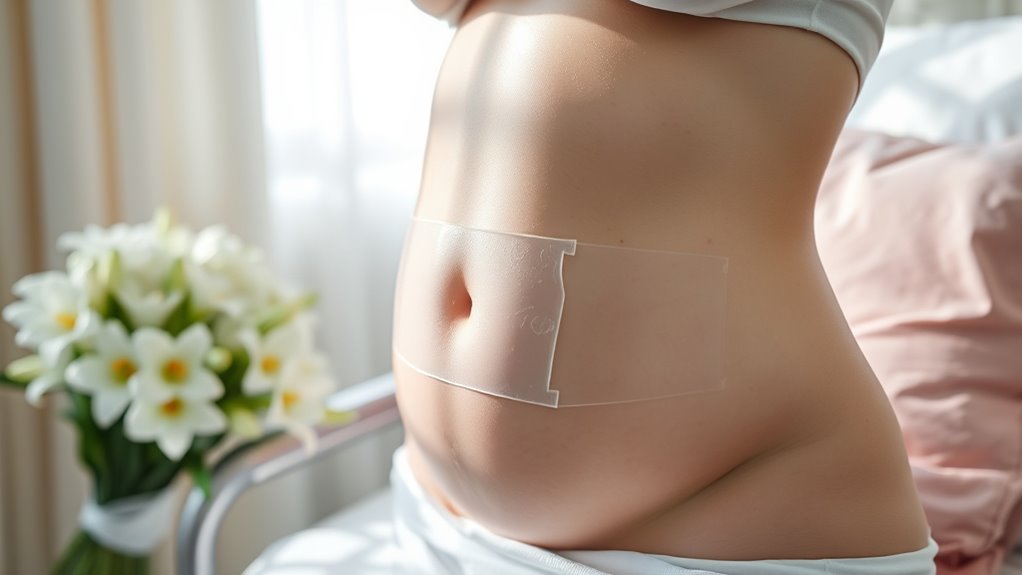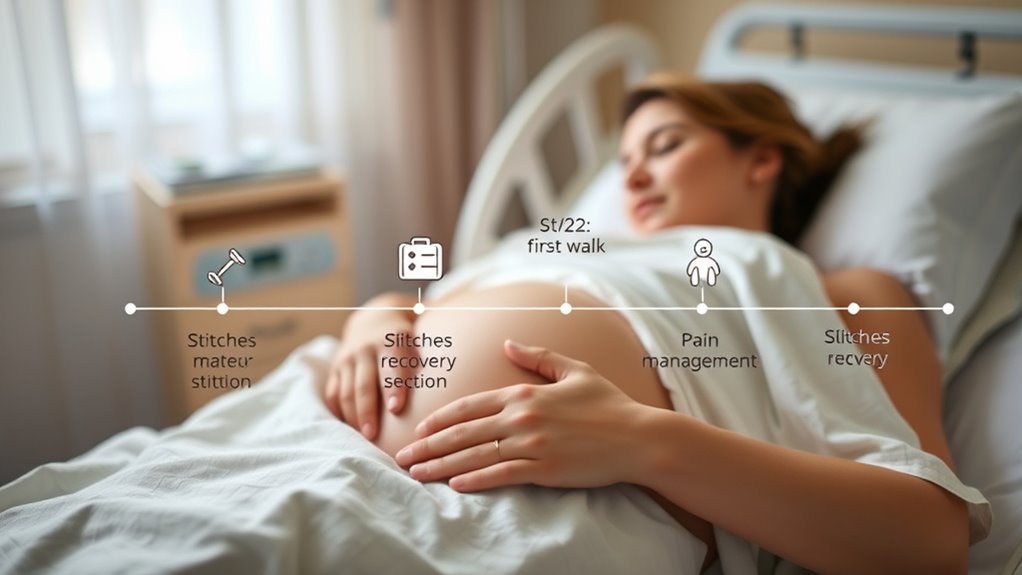After a cesarean, you’ll spend the first 24 hours closely monitored as you recover from anesthesia and pain. During the first week, focus on rest, keeping your incision clean, and gentle walking to support healing. Avoid strenuous activities for six weeks and watch for signs of infection. Over the next few months, your scar will fade, and mobility will improve. To understand your full recovery journey, continue exploring how to support your healing process.
Key Takeaways
- The first week involves initial healing, pain management, rest, gentle mobility, and incision care.
- Gradual return to light activities like walking begins within the first month, avoiding heavy lifting.
- Signs of infection or complications include fever, increased redness, swelling, foul discharge, or worsening pain.
- Full recovery typically takes 6-8 weeks, with ongoing scar care and monitoring for abnormal healing.
- Emotional well-being and patience are essential during the recovery process, alongside physical healing.
Immediate Post-Surgery Care and First 24 Hours

After your cesarean surgery, the first 24 hours are essential for your recovery. You’ll be closely monitored by medical staff to ensure your vital signs are stable and that you’re managing pain effectively. You might feel groggy from anesthesia and experience some discomfort at the incision site. It’s common to have a catheter in place to drain urine and IV lines for fluids and medications. Rest is critical, so try to relax and avoid unnecessary movements. Breathing exercises may be encouraged to prevent lung issues. You’ll also be encouraged to start gentle mobilization, like moving your legs, to reduce blood clots. Keep communication open with your care team so they can address any issues promptly. Empowering seniors with personalized in-home care can also support your recovery by providing tailored assistance as you regain your independence.
The First Week: Initial Healing and Rest

During the first week after your cesarean, your body begins the initial stages of healing. You might notice some fatigue as your body works to repair the incision and regain strength. Rest is essential, so listen to your body’s signals and take naps whenever needed. Keep your incision clean and dry to prevent infection, and avoid strenuous activities. You may experience some swelling, bruising, or mild discomfort, which is normal. Proper hydration and a balanced diet support healing, so focus on nourishing yourself. Gentle movement, like walking around the house, helps prevent blood clots and promotes circulation. Remember, your body is working hard to recover—patience and rest are your best allies during this vital first week. Also, maintaining good air quality can aid in your recovery by reducing exposure to airborne pollutants that may hinder healing.
Managing Pain and Discomfort in the Early Days

Managing pain and discomfort after your cesarean is essential for a smooth recovery. You can choose from various pain relievers and learn how to ease incision discomfort effectively. Finding the right balance between rest and gentle activity helps you heal faster and feel more comfortable. Using appropriate pain management techniques can significantly reduce your discomfort during these initial days.
Pain Reliever Options
In the early days after your cesarean, managing pain effectively is essential for your comfort and recovery. You’ll likely be offered different pain relievers, such as acetaminophen or NSAIDs like ibuprofen, which help reduce inflammation and discomfort. Your doctor may also prescribe stronger medications, like opioids, for more severe pain, but these are usually used sparingly and for short periods. It’s important to follow your healthcare provider’s instructions carefully to avoid side effects or dependency. Combining medication with gentle movement, rest, and relaxation techniques can enhance your comfort. Additionally, understanding Honda Tuning options can be useful if you’re interested in vehicle performance, but for now, focus on your recovery process. If you experience excessive pain or side effects, don’t hesitate to notify your medical team. Managing pain proactively helps you rest better and promotes a smoother recovery process.
Managing Incision Discomfort
After choosing appropriate pain relievers, paying attention to your incision area can substantially improve your comfort. Keep the incision clean and dry to prevent infection and reduce irritation. Gently pat the area with a clean cloth if it feels moist or sweaty, and avoid rubbing or applying harsh creams. Wearing loose, comfortable clothing helps prevent pressure on the incision. If you notice redness, swelling, or increased pain, notify your healthcare provider. Applying ice packs wrapped in a cloth can reduce swelling and numb discomfort—use for 15-20 minutes at a time. Remember to change positions slowly to avoid pulling or stretching the incision. Taking these small steps can make a significant difference in managing your incision discomfort during recovery.
Rest and Activity Balance
Balancing rest and activity is essential in the early days of recovery to minimize pain and promote healing. Rest allows your body to focus on repairing tissues, while gentle activity helps prevent stiffness and improve circulation. Listen to your body, and don’t push too hard too soon. Use the following guide to maintain a healthy balance:
| Activity Level | Duration | Tips |
|---|---|---|
| Resting | Most of the day | Prioritize sleep and naps |
| Gentle walking | 10-15 minutes daily | Boost circulation, avoid fatigue |
| Light household chores | 10-20 minutes | Avoid heavy lifting |
| Sitting and standing | Alternate every hour | Use pillows for support |
| Rest periods between activity | As needed | Prevent overexertion |
Find your rhythm, and adjust as you heal. Remember, understanding post-surgical recovery can help you better manage your healing process.
Physical Activity and Mobility During the First Month

During the first month after a cesarean section, gradually resuming physical activity and mobility is essential for a smooth recovery. Start with light movements, such as gentle walking around your home, to boost circulation and prevent blood clots. Avoid strenuous activities or heavy lifting, typically for at least six weeks, unless your doctor advises otherwise. Focus on listening to your body—if you experience pain, fatigue, or discomfort, slow down and rest. Incorporate pelvic floor exercises as recommended by your healthcare provider to strengthen muscles and support healing. Use support pillows or abdominal binders if needed to reduce strain. Staying mobile helps prevent stiffness and promotes healing, but always prioritize your comfort and follow your doctor’s guidance during this critical period. Special Events and Themed Breakfasts can provide motivational opportunities for gentle social activity as you recover.
Recognizing Signs of Infection or Complications

You should keep an eye out for a fever that won’t go away, as it can be a sign of infection. Check your incision site daily for redness, swelling, or unusual discharge. Also, monitor your pain levels and let your healthcare provider know if pain worsens or feels different than expected. Additionally, be aware that color accuracy in your healing environment can influence your ability to notice subtle changes in skin tone or signs of inflammation.
Watch for Fever
Have you noticed if your temperature starts to rise after your cesarean? A low-grade fever is common in the first 24 hours, but if your temperature climbs above 100.4°F (38°C) and persists, it could be a sign of infection. Keep track of how you’re feeling—shivering, chills, or sweating might accompany a fever. While some fluctuation is normal, a sustained or high fever warrants attention. Don’t dismiss this symptom. It could indicate an infection at your surgical site, uterine infection, or other complications. Check your temperature regularly, especially if you’re feeling unwell or fatigued. If your fever persists or worsens, contact your healthcare provider promptly to ensure proper care and prevent further issues. Recognizing infection signs early can help prevent more serious health problems.
Check Incision Site
While keeping an eye on your incision site, it’s important to look for signs of infection or complications. Check for redness, swelling, or warmth around the incision. Look for any unusual drainage, especially if it’s pus or has a foul smell. Keep an eye out for increased pain or tenderness beyond the normal discomfort. If the incision begins to open or there’s visible separation, seek medical attention immediately. Also, monitor for any bleeding that seems excessive or doesn’t slow down. If your incision feels hot to the touch or you notice spreading redness, these could be warning signs of infection. Being vigilant helps catch problems early, ensuring you get prompt treatment and a smoother recovery. Familiarity with postoperative signs can further aid in recognizing potential issues.
Monitor Pain Levels
How can you tell if your pain is a normal part of recovery or a sign of infection? First, pay attention to the intensity and persistence of your pain. If it worsens over time or is unrelieved by pain medication, it could be a warning sign. Second, watch for additional symptoms like fever, chills, or foul-smelling drainage. Third, monitor your incision site for redness, swelling, or increased warmth.
Here are some key signs to watch for:
- Increasing pain that doesn’t improve with medication
- Fever above 100.4°F (38°C) or chills
- Unusual or foul-smelling drainage from your incision
If any of these occur, contact your healthcare provider promptly.
Returning to Daily Activities and Light Exercise

As your body begins to heal, gradually returning to daily activities and light exercise is essential for a smooth recovery. Start by slowly resuming basic tasks like walking around your home. Listen to your body—if you feel pain or discomfort, take a break. Short, gentle walks help improve circulation and prevent blood clots. Avoid lifting heavy objects or strenuous activities until your doctor clears you. Incorporate light stretching and deep breathing exercises to promote flexibility and relaxation. Prioritize rest and hydration to support healing. Remember, patience is key; rushing back too soon can cause setbacks. As you regain strength, gradually increase activity levels, always paying attention to how your body responds. Exploring safe exercise guidelines can help you stay on track during recovery. This steady approach helps ensure a safe and comfortable recovery process.
Emotional Well-Being and Postpartum Support

Have you noticed your emotional state shifting during your postpartum recovery? It’s normal to experience ups and downs. Your body’s adjusting, and so is your mind. To support your emotional well-being, consider these key steps:
- Reach out to loved ones or a support group—sharing your feelings helps lighten the load.
- Prioritize self-care, including rest, nutrition, and gentle activities to boost your mood.
- Seek professional help if feelings of sadness or anxiety persist—mental health support is essential.
Long-Term Healing and Scar Care

Long-term healing after a cesarean section involves caring for your incision and supporting your body’s recovery over time. Proper scar care can promote healing and reduce visibility. Keep the area clean and moisturized, and avoid irritating fabrics. Protect your scar from sun exposure to prevent darkening. You might notice some numbness or tightness as nerves regenerate. Regularly check for signs of infection or abnormal healing. To help you stay engaged, here’s a quick guide:
| Tip | Why it helps |
|---|---|
| Keep the incision clean | Prevents infection |
| Use scar creams or silicone gels | Supports scar maturation |
| Avoid sun exposure | Prevents dark scars |
| Practice gentle massage | Improves blood flow and elasticity |
When to Resume Work and Normal Routine

As you recover, pay attention to your healing milestones and how your pain and fatigue levels change. These signs can help you determine if you’re ready to return to work and your daily routine. Listening to your body guarantees a smoother shift back to normal activities.
Healing Milestones Achieved
Typically, many women begin to feel ready to resume light activities and return to work around six weeks after a cesarean section, but this can vary based on individual healing progress. By this time, you may notice key milestones indicating your recovery is on track.
- Your incision site feels less tender and shows signs of healing, with minimal swelling or redness.
- You can comfortably walk around without excessive fatigue or discomfort.
- You’re able to perform daily tasks like lifting light objects and caring for your baby without pain or strain.
Reaching these milestones suggests your body is recovering well. However, listen to your healthcare provider’s advice and avoid rushing back into strenuous activities too soon.
Pain and Fatigue Levels
Understanding your pain and fatigue levels is essential before resuming work or normal activities. You might notice some discomfort and tiredness in the weeks after surgery, but these should gradually decrease. Pay close attention to your body’s signals—if pain worsens or fatigue becomes overwhelming, it’s a sign to rest more. Mild soreness around the incision site is normal, but intense pain isn’t. Fatigue can linger, so don’t push yourself too hard too soon. Rest is critical for healing, and listening to your body helps prevent setbacks. Keep track of how you feel daily, and consult your healthcare provider if you experience persistent or severe pain, excessive tiredness, or other concerning symptoms. Your recovery depends on respecting your current limits and giving yourself time to heal properly.
Workplace Readiness Signs
Determining when you’re ready to return to work and your normal routine depends on several clear signs. First, you feel physically capable without significant pain or fatigue. Second, your energy levels are stable enough to handle daily tasks and responsibilities. Third, you’re confident that your incision has healed well, with no signs of infection or discomfort.
Keep an eye out for these signs:
- You can sit, stand, and move comfortably for extended periods.
- You’re able to lift your baby and perform routine chores without pain.
- You feel mentally prepared and confident to re-engage with work duties.
If these signs are present, you’re likely ready. If not, give yourself more time to heal fully.
Factors That Can Influence Recovery Time

Your recovery time after a cesarean section can vary considerably depending on several key factors. Your overall health before surgery plays a big role—if you’re in good shape, you’ll likely heal faster. The complexity of your procedure also matters; a straightforward cesarean usually means quicker recovery than an emergency or complicated one. How well you follow post-op instructions affects healing too—rest, hydration, and gentle activity promote faster recovery. Your age and any underlying conditions, like diabetes or infections, can slow down healing. Additionally, your support system and access to quality healthcare influence your progress. Staying proactive, listening to your body, and seeking prompt medical care when needed help guarantee a smoother, quicker recovery process.
Frequently Asked Questions
How Does Breastfeeding Affect Cesarean Recovery?
Breastfeeding plays a positive role in your cesarean recovery. It encourages the release of oxytocin, which helps your uterus contract and reduces bleeding. Plus, it promotes bonding with your baby and can boost your mood. While it may be tiring initially, breastfeeding can aid your healing process by stimulating blood flow and encouraging movement. Just listen to your body and seek support if needed, ensuring a smoother recovery.
Are There Specific Dietary Recommendations During Recovery?
During your recovery, it’s important to follow specific dietary recommendations to support healing. Focus on eating plenty of fruits, vegetables, lean proteins, and whole grains to boost your energy and repair tissues. Stay well-hydrated by drinking water and avoid greasy, processed foods that can cause discomfort. Incorporate iron-rich foods to prevent anemia, and listen to your body’s needs. Proper nutrition helps you heal faster and feel better during this essential time.
What Mental Health Challenges May Arise Postpartum?
Think of your mind as a delicate garden, vulnerable to weeds like postpartum depression or anxiety. You might feel overwhelmed, exhausted, or mood swings, like storms passing through. These mental health challenges are common and deserve attention. Reach out to loved ones or professionals when needed. Nurture your emotional well-being with patience, self-compassion, and time, knowing that, like a garden, your mind can heal and blossom again.
Can Physical Therapy Speed up Healing?
Physical therapy can definitely help speed up your recovery after a cesarean section. It strengthens your muscles, improves circulation, and reduces pain, making it easier to move comfortably. By working with a specialized therapist, you’ll learn gentle exercises that promote healing without overdoing it. Keep in mind, though, everyone heals at different rates, so listen to your body and follow your healthcare provider’s guidance for the best results.
How Does Cesarean Section Impact Future Pregnancies?
Think of your body as a delicate garden; each pregnancy and birth is a season of growth. A cesarean section leaves a scar, but it doesn’t lock you out of future pregnancies. Instead, it’s like tending to your garden carefully, knowing there may be some extra watering or pruning needed. With proper care and medical guidance, you can nurture new life and ensure your future pregnancies flourish just as beautifully.
Conclusion
As you gradually regain your strength, picture yourself stepping into a new chapter, each day a gentle wave washing over the scars of surgery. With patience and care, your body will heal like a delicate bloom unfolding in sunlight. Trust in your resilience, listen to your body’s whispers, and embrace the journey ahead—knowing that, soon, you’ll walk forward with renewed confidence, your story of recovery unfolding beautifully like the dawn after a long night.









